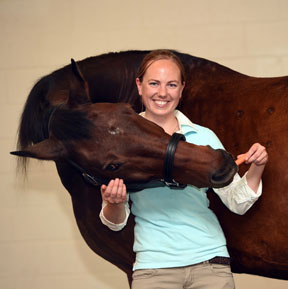
Michael Dicks 288

Photo by Dr. Melissa Maddux
Following his retirement in 2018 as chief economist of the American Veterinary Medical Association, Michael Dicks embarked on a sail along the Eastern Seaboard last year.
The appearance of a new zoonotic spillover event, the COVID-19 pandemic, has tipped the scale toward recession in an already lethargic U.S economy. For more than a year, the economy has been sputtering but given just enough fuel to keep from stalling. Like a 1968 Volkswagen bug, steadily moving forward in no hurry, the U.S. economy has gone through periods of racing downhill and then using momentum to make it up the next hill. The goal is to keep moving forward because if it stalls, it will take a long time to get back up to speed.
Last fall, the Federal Reserve responded to a "sputter" by lowering the interest rate charged to banks. It also resumed buying back U.S. Treasury securities and bonds, a tactic employed to inject cash into a flagging economy. This provided the necessary fuel for the economy to make it up the next hill, by keeping consumers confident and their savings moving into investments in equity markets, public and private alike.
Ensuring continued demand for equities added further fuel to the bull market, maintaining the growth in equity prices, with an associated positive effect on consumer confidence. The Federal Reserve’s creation of low-cost credit, coupled with business tax savings from the Tax Cuts and Job Act of 2017, gave businesses access to cheap cash that they could use to buy back their stock shares. All these factors helped facilitate the purchase by private equity firms of assets such as veterinary practices. The average annual rate of growth in consolidation from 2017 through 2019 was 13%.
Then the pandemic hit. State governments closed non-essential businesses in an effort to stem transmission of the coronavirus. Although a critical public-health measure, closing businesses reduces economic activity. It increases unemployment, reduces consumers' ability to purchase goods and services, and reduces consumer confidence in the future. These effects, in turn, reduce investment in equity markets and therefore, funding for corporate consolidation.
Dr. Melissa Maddux 288

Photo by Phil Snow
In addition to running a veterinary business consultancy, Dr. Melissa Maddux practices equine and small animal medicine in Knoxville, Tennessee. She is shown with a horse named Camilla.
Will the pandemic end corporate offers for veterinary practices? The short answer is no. But, like economic activity as a whole, consolidation will be on hiatus. (For a discussion of what drives consolidation of veterinary practices, see "Veterinary practice consolidation demystified," an article we wrote last year.)
Over the long term, there is no sign that veterinary practices will not remain profitable and provide high returns on investment. This is largely because the number of pet-owning households is increasing, and the percentage of those households that consider their pets to be family members, now nearly 70%, continues to grow. As long as practices continue to offer high returns, they likely will remain targets for consolidation when the economy recovers.
For now, though, purchase offers from consolidators are apt to be made less frequently. Private equity firms and the consolidators they fund rely on the availability of investment dollars and their own ability to generate high returns on investment to stay in business. It is likely that they will be greatly challenged in the next year, as the pandemic drags on and investment dollars become scarcer.
Are we headed for another Great Recession?
Memories of the 2008-09 recession are still fresh on the minds of most business owners and consumers. As a result, businesses and consumers alike are responding to the current economic halt with defensive and self-preserving behavior — an attitude of "keep what I have, and work with that." Such behavior forestalls new investment, eliminates conspicuous consumption (new appliances, vehicles, vacations, recreational items, entertainment), increases unemployment and underemployment, and reduces the gross domestic product.
Communicate, communicate
Communicate with clients. Explain your current situation, new protocols the hospital has adopted to keep everyone safe and maintain high-quality care, and how you can help overcome barriers (such as through payment plans or use of telemedicine). Some practices may wish to offer lower-cost care for a period while clients are financially strapped.
Communicate with your community. Share the importance of maintaining wellness care, for both the pet's health and the pet's family's health. This message could be delivered jointly with other practices in the area. Provide mechanisms for the community to financially support the veterinary needs of pets whose owners have been directly affected by the pandemic (how about a community care fund?) and explore options for payment plans or accepting delayed payments.
Communicate with your clinic team. As much as possible, be transparent about the practice's financial situation. Involve everyone in creating cost-reducing, resource-conserving and revenue-growing strategies. Establish clear goals and enable team members to take ownership of achieving the goals.
Communicate with suppliers. Enlist product suppliers in offering assistance in meeting the immediate needs of pets and producers, especially with vaccines and parasiticides that directly serve to protect public health or food safety. Pharmaceutical representatives and the companies they work for should be part of the team and understand that everyone is in this together. For example, can they provide leeway in billing for products so that veterinarians, in turn, can provide leeway to clients?
Prepare for an economic downturn
Build a response team. Members may include an accountant, financial adviser, local bank, business consultant, mentor, sales representatives and distributors.
Secure cash flow and the financial health of your practice.
- Reduce discretionary spending (e.g., conferences, continuing education, travel).
- Build a cash reserve. Obtain an operating note from a bank (there is no cost if it is not used but is there if you need it), renegotiate loans (take advantage of historically low interest rates), renegotiate insurance policies and consolidate bank accounts.
- Re-examine the hospital's inventory management system. Adjust quantities based on changes in demand, seasonal trends or new delivery lead times. Renegotiate payment terms if possible.
- Eliminate debt or reduce the cost of capital.
Apply for federal, state and local support programs before you need them. The wait time for many programs is long, so plan and build your safety net early.
The U.S. stock market lost roughly 30% of its value from its peak on Feb. 12 as a result of the initial response to the pandemic, reducing the balance sheet (equity or net worth) of many investors. Some of the losses have since been regained, but the stock market overall remains likely to experience a major decline. The production of non-essential goods and services has been dramatically reduced. While the response and the effect on economic activity is the same, the cause of this new recession is very different from the last.
Not unlike most recessions, the 2008-09 recession resulted from too much production chasing too few consumers. To recap, the centerpiece of the 2008 downturn was the real estate market. Cheap and easy credit led consumers to gobble up housing, stimulating construction of more housing. Unfortunately, much of the cheap loans were for a short term (three to five years); credit subsequently became much more expensive. Many who had purchased homes found they no longer could afford them. Demand evaporated. Housing values tanked. Creditors holding mortgages saw their value cut in half. The result was a severe scarcity of capital. The Federal Reserve stepped in, buying trillions of dollars of the debt.
In a typical recession, large and growing inventories, followed by a decline in demand (or unwillingness to pay), trigger businesses to reduce production, which sets off a chain of events that include reduced work hours, initial layoffs, even less consumption, more reduction in output and more layoffs.
Today's situation is different. Conspicuous consumption has been cut off by government policy. The economy is in hibernation rather than in a typical recession. All the economic actors are waiting for spring.
But when will spring come? No calendar can tell us. The uncertainty has several distinct components or stages: The effects of COVID-19 itself (stage one); the effects of the federal and state reaction to COVID-19 (stage two); the federal and state responses to the economic damages of COVID-19 and associated federal responses (stage three); and lastly, what the government response will be to the adverse consequences of the $2.2 trillion CARES Act, Federal Reserve debt-purchasing programs, interest-rate reduction and associated policies and programs (stage four).
We are experiencing stages one and two now. Stage three is unfolding. All indications are that the government will continue to add funding and make program changes in an attempt to help the economy regain its previous pace, and the Federal Reserve will continue to add capital to ensure cheap credit. This process of attempting to minimize the economic impacts of the shutdown is likely to continue into next year.
Once the pandemic is officially behind us (perhaps with the development of a vaccine), the economy will be on its own. That's when consequences of the emergency economic actions taken by the federal government (and Federal Reserve) will become apparent. The debt accumulated by the federal government to respond to the pandemic and by businesses to cover expenses during the shut-down will dampen future earnings. Capital will likely be increasingly scarce and thus more expensive, squeezing government budgets. These problems may take years to work through.
The ability of the government to anticipate and respond to these long-term economic impacts will determine the length of the current economic downturn. The current downturn already exceeds the depth of the last recession but the more important duration of the downturn is unknown. It will depend on the government’s ability to offset the economic consequences of the hibernation, and the number of resources available to the government at the end of the hibernation.
Anticipating this, businesses have an opportunity now to prepare, in order to withstand the impacts. Make plans on the expectation that stages one to three will last 18 to 24 months. Anticipate that stage four will unwind for two to five years; maybe longer.
In the near term, veterinarians can benefit by engaging with the government efforts to shore up the economy. Note that all of the emergency legislation must be implemented by a reduced government workforce that, in general, has limited knowledge of the veterinary profession. Under pressure to urgently get benefits into the hands of those who need them, programs and policies may not be implemented in a manner that is helpful to all veterinary practices.
Veterinary practices are diverse, providing a vast and differing array of animal services in their communities. This makes them difficult to understand and easy to overlook. Practice owners should proactively work with state and national associations to ensure that the full range of veterinary voices are heard during the rule-making process, and that programs are designed to meet everyone’s needs.
An opportunity to lead
Hardship asks us to re-evaluate our purpose, our goals, and how we accomplish them. Although the challenges and uncertainty before us undoubtedly bring struggle, they also grant us opportunity to emerge better than we were before.
The pandemic has not changed the willingness of pet owners to purchase veterinary care for their four-legged (or feathered) family member. What has changed is their accessibility to the practice and, for some, their ability to pay.
Veterinarians and their teams are resourceful problem-solvers, trained for situations that don’t follow the book. Along with human safety protocols, hospitals may be asked to adopt low-cost care strategies, implement new payment methods, conserve resources without compromising patient outcomes, and integrate techniques for long-distance care (e.g., telemedicine). This is a golden opportunity for everyone in veterinary practice to rise as leaders in their communities, practice empathy and show clients that they are not alone. Everyone is here to face this challenge together.
About the authors:
Michael Dicks, PhD, established the veterinary economics division of the American Veterinary Medical Association in 2013 and was its director until 2018. Dicks earned a BS in biochemistry and animal science from California Polytechnic State University, taught chemistry as a Peace Corps volunteer in Kenya, then completed graduate degrees in agricultural economics at the University of Missouri. Dicks worked at the U.S. Department of Agriculture Economic Research Service and served on the faculty of Oklahoma State University prior to joining the AVMA. He now works as a consultant.
Melissa Maddux, DVM, is a 2016 graduate of the University of Tennessee College of Veterinary Medicine, a former AVMA economics fellow and CEO of Erupt, a veterinary business consultancy. She also practices small-animal and equine medicine.